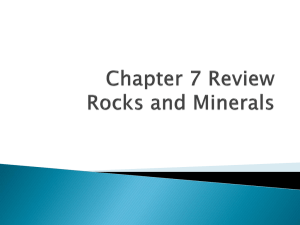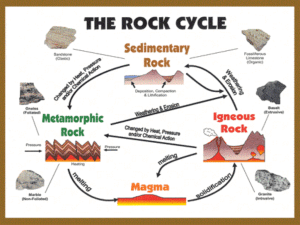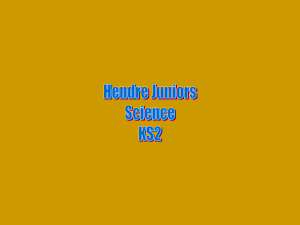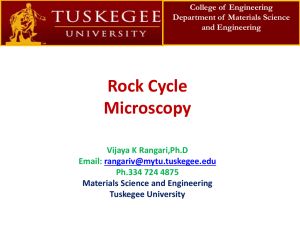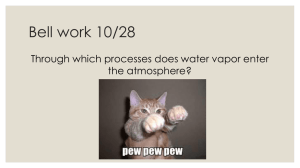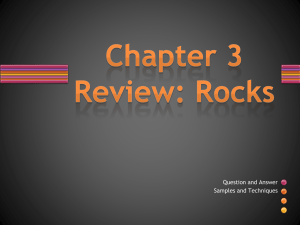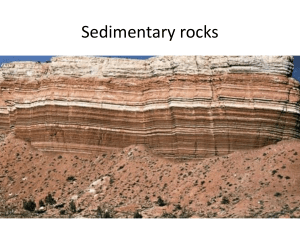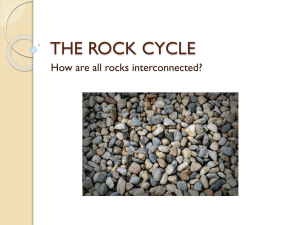Rock Cycle
advertisement
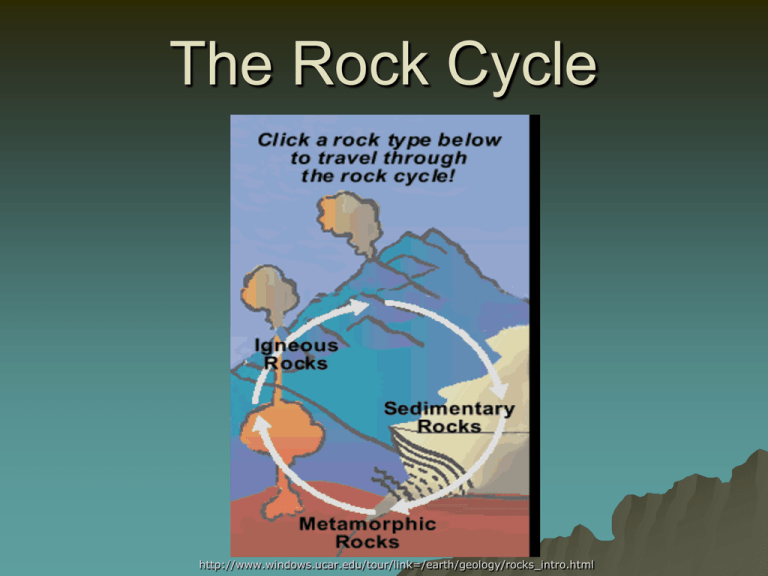
The Rock Cycle http://www.windows.ucar.edu/tour/link=/earth/geology/rocks_intro.html Rock Cycle Rock: Earth material made of minerals, glass or organic matter Rock Cycle: the process by which, over many years, Earth materials change back and forth among magma, igneous rocks, sediments, sedimentary rocks and metamorphic rocks Igneous Rocks: rock formed when magma or lava cools Lava: molten rock from a volcano flowing on Earth’s surface Magma: molten rock beneath Earth’s surface Intrusive: igneous rocks that form below Earth’s surface (plutonic) Extrusive: igneous rocks that form when magma extrudes onto Earth’s surface and cools as lava (volcanic) Igneous Rocks Basaltic or Mafic: darkcolored igneous rocks that form from magma rich in iron & magnesium (high ferromagnesium minerals; low silica) Granitic or Felsic: lightcolored igneous rocks, form from magma rich in silicon and oxygen (low ferromagnesium minerals; high silica) Igneous Rock Textures A rock’s texture depends on the - size, - shape, and - arrangement of crystals A crystal’s size and shape depends: - rate of cooling - amount of dissolved gasses Composition – types of minerals within a rock Structure – orientation of minerals or rock fragments in a rock Coarse Grained Mineral grains large enough to be seen with the unaided eye (Phaneritic): Granite or Gabbro Fine Grained Mineral grains too small to be seen with the unaided eye (Aphanitic): For example: Rhyolite or Basalt Glassy Cooled so quickly that no crystals were able to be formed Obsidian or Pumice Scoria Porphyritic Texture Displays two stages of cooling… slow and then fast (or quenched) Composition within a rock Structure – types of minerals – orientation of minerals or rock fragments in a rock Sedimentary Rocks: rock formed when sediments become pressed or cemented together Sediments: loose materials such as rock fragments and mineral grains that have been transported by wind, water, or glacier Weathering: the breaking of rocks into smaller pieces, either mechanically or chemically Erosion: the process that moves weathered rocks from one location to another Deposition: the build up of sediments on the bottoms of lakes, valleys and the ocean floor usually in layers Compaction: sedimentary rockforming process that occurs when layers of sediment become compressed by the weight of layers above them Cementation: sedimentary rockforming process in which sediments are glued together by minerals deposited between the sediments Three types of Sedimentary Rocks: Clastic Sedimentary Rock: made of broken fragments of plants, animals, and primarily other rocks Examples of Clastic Sedimentary Rocks Conglomerate- composed of rounded, pebble-sized fragments that are held together by a cement Examples of Clastic Sedimentary Rocks Breccia - composed of angular, pebblesized fragments that are held together by a cement Examples of Clastic Sedimentary Rocks Sandstone – composed of small mineral grains (usually quartz) that are cemented together. Examples of Clastic Sedimentary Rocks Shale – made of flaky clay particles that compress into flat layers Chemical Sedimentary Rocks made from minerals precipitated from a solution or are left behind when a solution evaporates – minerals left behind form rocks called evaporites Rock salt (halite) Organic Sedimentary Rock primarily made from the remains of once living things Examples of Organic Sedimentary Rock Limestone Fossiliferous Limestone Chalk Example of Organic Sedimentary Rock Coal - forms from plant remains that are buried before they decay. The plant layers are then compacted into matter that is composed mostly of carbon Metamorphic Rock: rock formed from existing rock when the temperature or pressure changes Textures of Metamorphic Rocks Foliated: a texture of metamorphic rock, created when mineral grains flatten and line up in parallel bands Nonfoliated: texture of metamorphic rock, created when mineral grains change, grow, & rearrange but don’t form bands Local Metamorphism metamorphism that affects relatively small volumes of rock (less than 100 km³) Regional Metamorphism metamorphism that affects thousands of (km³) cubic kilometers of rock Contact Metamorphism metamorphism where temperature is the primary agent Limestone Marble Basalt Marble Limestone http://academic.brooklyn.cuny.edu/geology/grocha/monument/images/metheat.gif Dynamic Metamorphism http://www.indiana.edu/~g103/G103/wk5/week5.htm metamorphism where pressure is the primary agent (aka deformational metamorphism) Result of Dynamic Metamorphism http://www.indiana.edu/~g103/G103/wk5/week5.htm Examples of Metamorphic Rocks Gneiss – metamorphosed granite, displays foliation and banding; a result of high grade metamorphism (foliated texture) kinked gneiss Examples of Metamorphic Rocks Slate – pressure exerted on shale (claystone/ mudstone) Schist – high heat and pressure exerted on slate http://library.thinkquest.org/05aug/00461/images/slate.jpg (both with foliated texture) http://www.windows.ucar.edu/tour/link=/earth/geology/images/Schist_mica_jpg_image.html Examples of Metamorphic Rocks Quartzite – metamorphosed quartz sandstone (looks like fine crystalline structure) http://www.answersincreation.org/curriculum/geology/images/Quartzite_2_jpg.jpg Marble – formed from the compression of limestone (looks like numerous calcite crystals) (both with nonfoliated texture) http://www.answersincreation.org/curriculum/geology/images/Marble_2_jpg.jpg On your hiking tour of the west, your travel group decides to take a break at a nearby stream. You get one look at that clean, cool water and quickly figure out that this would be an awesome spot to soak your tired feet. As you place your feet in the water, you notice some shiny stuff in the bottom of the stream. “Is it gold?” you think to yourself. How could you determine if it is? What tests would you use? Which tests would not be good to use to identify this as gold? http://www.eastchester.k12.ny.us/sc hools/hs/teachers/fermann/Links1.ht m Map Data Table 1 Station No. # of visits Station No. 1 7 2 8 3 9 4 10 5 11 6 # of visits Data Table 2 Station 1 - Compaction and Cementation (write information/draw diagrams regarding station 1 here) Station 2 - High Temperature and Pressure (write information/draw diagrams regarding station 2 here) List of Stations Compaction and Cementation 2. High Temperature and Pressure 3. Sediments 4. Igneous rock 5. To the surface 6. Metamorphic rock 7. Sedimentary rock 8. Melting 9. Cooling and hardening (solidification/crystallization) 10. Magma 11. Weathering and Erosion 1. Rock Cycle Roulette – write-up 1. 2. 3. 4. 5. Entire lab is to be typed. Map: create 3 long boxes on the computer and HAND DRAW the arrows. Data Table 1: Create a table (either in Microsoft Word or Excel) with tally marks to indicate how many times you went to each station. Data Table 2: type the information at each of the stations IN ORDER (Station 1 – Station 11) AND recreate the diagrams (by hand) at the appropriate stations. Answer the questions and conclusion questions fully, with the question implied in the answer.

